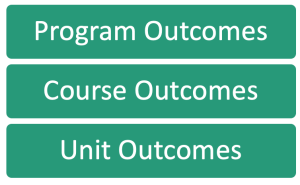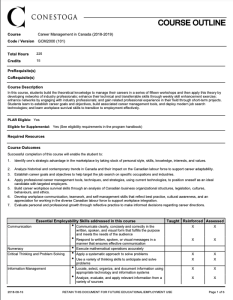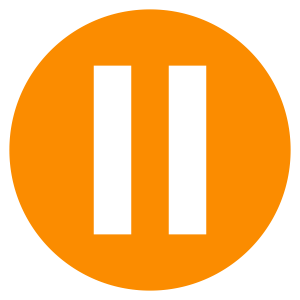1.2 Outcomes, Alignment, and Curriculum
Learning Outcomes
Identify Conestoga’s commitment to delivering outcomes-based education.
Conestoga’s Credentials
Conestoga College offers many types of credentials types, including micro-credentials, certificates, diplomas, bachelor degrees, post-graduate certificates, and more! Our complete list of college credentials includes the following:
- Micro-credentials
- Certificate of Achievement
- College Certificate
- Ontario College Certificate
- Ontario College Diploma
- Ontario College Advanced Diploma
- Ontario College Graduate Certificate
- Baccalaureate Degree (3 Years)
- Honours Baccalaureate Degree (4 Years)
A diploma program is two or three years in length, while most certificate programs are completed in one academic year. But there are some exceptions!
Conestoga’s credentials are conferred following the achievement of learning outcomes. Every program has program outcomes, and every course has course outcomes. This focus on outcomes is known as outcomes-based education. If you’d like to know more, please refer to Conestoga’s academic credential procedure.
Outcomes-Based Education
Outcomes-based education is suitable for learners: it requires that students engage actively in their learning and demands and the progressive development of skillsets through scaffolded learning opportunities (Matthews & Mercer-Mapstone, 2018).
Conestoga provides outcomes-based education. Outcomes-based education is learning by outputs: it focuses on goals, products, results, and effects to demonstrate competence with the stated learning outcomes (Killen, 2007). Students must demonstrate required outcomes to graduate from their program.
Learning outcomes are direct statements describing the knowledge, skills, and attitudes students are expected to demonstrate by the end of a course or program. Learning outcomes are observable, measurable, and significant.
Academic Learning Outcomes
There are different forms of learning outcomes for academic programs
-

Fig. 1.2.2 Hierarchy of outcomes, CC0 Program outcomes provide the “big picture” of students’ cumulative learning in the program. For non-degree credentials, program learning outcomes may also be called vocational learning outcomes.
- e.g., “When students complete this program, they should be able to… “
- Course outcomes are the broad goals, or terminal learning accomplishments, that students should be able to achieve by the end of the course. The purpose of evaluations is to ensure that course outcomes are met.
- e.g., “When students complete this course, they should be able to…”
- Unit outcomes prepare students to demonstrate course learning outcomes by scaffolding their learning processes. The unit outcomes relate to the course outcomes.
Course outcomes are the critical core competencies that guide your course’s design and delivery. Course outcomes support students to be able to demonstrate program outcomes by the end of their program.
Outcomes for Working and Living
In addition to learning outcomes, the Ministry of Colleges and Universities has identified common skills that are “equally valuable for all graduates …whether they pursue a career path, or they pursue further education” (Framework for Programs of Instruction, pg 19).
- In Ontario College Certificate, Diploma, and Advanced Diploma programs, these skills are called Essential Employability Skills (EES).
- In Bachelor Degree and Honours Bachelor Degree (DLO) programs, these skills are called Degree Level Learning Outcomes (DLLO).
Where program, course, and unit learning outcomes are vocational, EES and DLLO are non-vocational skills critical for success in the workplace, day-to-day living, and lifelong learning that students learn as part of the formal curriculum and as stipulated by the Ministry.
5-Minute Reflection Activity
Stop and reflect:
- What was the last credential or program you took? How were you made aware of the learning outcomes of that program?
- What are some of the advantages of outcomes-based education for college students?
Curriculum and Alignment
The College maintains the quality of its programs and courses through curriculum alignment. Curriculum alignment is when outcomes, teaching activities, and assessments all match. Curriculum alignment ensures that learning is scaffolded and supported and avoids unnecessary duplication and repetition (Fraser, 2006).
Conestoga’s programs and courses are backwards designed. This means that outcomes are identified first, then assessments and teaching activities are created to ensure that students demonstrate the outcomes and have structured learning opportunities to practice and achieve the outcomes (Wiggins & McTighe, 2005).

Figure 1.2.3 visualizes how outcomes, assessments, learning opportunities, and resources connect. Each element (i.e., assessments, learning opportunities, etc.) must align to ensure curriculum quality and integrity. As a faculty member, you must ensure the course follows the Course Outline, which provides vital outcome and assessment information.
5-Minute Video Watch
View a short video overview of the relationship between curriculum alignment and assessment in your courses with Lauren Spring, Teaching and Learning Consultant.
Teaching and Learning. (2023). Curriculum alignment, integrity, and authentic assessment in your course. [Online video]. Panopto.
Course Outlines

Your Course Outline provides course and unit outcomes, the assessment evaluation structure, and required resources. The course outcomes are aligned with program outcomes.
You can be assured that your Course Outline has been carefully prepared and vetted to align with Ministry and Conestoga requirements by the academic program team, the Chair or Chair Designate, and the Curriculum Operations and Planning Department.
The Curriculum Operations and Planning Department approves Course Outlines. It supports developing and reviewing outcomes and other course elements so that assessments, learning activities, and learning resources stay aligned.
Changes to Course Outlines occur annually after the course has been completed for the academic year, in May or June.
5-Minute Reflection Activity
Reflect on the following questions:
- Have you ever taken a course or program where there was a lack of alignment with the outcomes, the activities, and the assessments? What was your reaction to that learning experience?
- What is the benefit of referencing course outcomes in your class while you teach students?
Curriculum Support for Faculty

The Annual Program Reflection (APR) is a high-level assessment of programs conducted by Chairs and program teams through an online framework. The cycle begins in May and concludes in August of that year; it requires academic program teams to contribute to the reflection of the last academic year and plan for the upcoming academic year.
The Major Program Review (MPR) and Degree Self-Study are comprehensive reviews. Comprehensive program reviews require program teams to undertake a strategic assessment supporting the Ministry and accrediting bodies’ program requirements. Most programs follow a five to seven-year review cycle unless external and internal circumstances identified through the annual reflections indicate the need for a revised review cycle.
See the chart below for College departments that support various curriculum development and review processes.
| Department | Process(es) |
| Curriculum Operations and Planning | Supports academic schools in the development and revision of Course Outlines |
| Degree Quality and Accreditation Department | Supports the development, planning, accreditation, and review of degree programs, i.e., the Degree Self-Study |
| Program Quality Assurance Department | Supports the Annual Program Reflections (APRs) for all programs, Major Program Reviews (MPRs), and accreditations for all non-degree programs |
If you have ideas for course changes, bring them forward during the APR or Comprehensive Review processes. If you have any questions, contact the Program Quality Assurance Department, Degree Quality and Accreditation Department, or the Curriculum Operations and Planning Department through the College directory.
5-Minute Search Activity
Find curriculum information and support now!
- Access Conestoga’s Course Outlines in the Employee Portal by selecting the “Course Outline” tab, typing in the search field of your course code or name, and selecting “Search.”
- Find a curriculum consultant in the College directory under “Curriculum Operations and Planning,” or send a message to Curriculum Planning and Operations (mail).
References
(2006). Shaping the university curriculum through partnerships and critical conversations. International Journal for Academic Development, 11(1), 5-17, DOI: 10.1080/13601440600578748
Killen, R. (2007). Teaching strategies for outcomes-based education. Juta and Company Ltd.
Matthews, K. E., & Mercer-Mapstone, L. D. (2018). Toward curriculum convergence for graduate learning outcomes: Academic intentions and student experiences. Studies in Higher Education, 43(4), 644-659. https://doi:10.1080/03075079.2016.1190704
Wiggins, G. P., & McTighe, J. (2005). Understanding by design (2nd ed.). Pearson.
 Section 1.2 Review
Section 1.2 Review
Please pause and answer these eight practice questions to review and check your learning.
